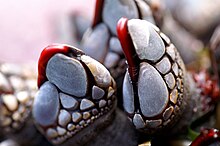Pollicipes polymerus
| Pollicipes polymerus | |
|---|---|
 |
|
| Scientific classification | |
| Kingdom: | Animalia |
| Phylum: | Arthropoda |
| Subphylum: | Crustacea |
| Class: | Maxillopoda |
| Infraclass: | Cirripedia |
| Order: | Pedunculata |
| Family: | Pollicipedidae |
| Genus: | Pollicipes |
| Species: | P. polymerus |
| Binomial name | |
|
Pollicipes polymerus (Sowerby, 1883) |
|
| Synonyms | |
|
|
Pollicipes polymerus, commonly known as the gooseneck barnacle or leaf barnacle, is a species of stalked barnacle. It is found, often in great numbers, on rocky shores on the Pacific coasts of North America.
Barnacles are classified with shrimps, crabs, isopods and amphipods in the subphylum Crustacea. They are included in the class Maxillopoda, though this class does not appear to be a monophyletic grouping. They are included in the infraclass Cirripedia, the barnacles, members of which are sessile suspension feeders with two active swimming larval stages, the nauplius and the cyprid. The order Pedunculata includes barnacles attached to the substrate by stalks, the goose barnacles. The attachment is made by the cementing of the antennules of the cyprid larvae to the substrate and the elongation of that region into a stalk. Pedunculata is not itself a single monophyletic group but forms a transitional series of lineages moving towards the sessile acorn barnacles.Pollicipes polymerus is included in the family Pollicipedidae.
Pollicipes polymerus is attached to rocks or other objects by a strong, rubbery stalk, the peduncle, which is up to 10 centimetres (4 in) long. It has a muscular interior and the leathery surface is covered in bands of minute spiny scales on short stalks. The capitulum, at the end of the peduncle, is up to 5 centimetres (2 in) long and contains the rest of the body including all the limbs and other appendages except the first pair of antennae. The outside of the capitulum bears five strengthening calcareous plates corresponding with the plates that protect an acorn barnacle. The largest of these is the carina, on the morphologically dorsal side of the capitulum, with a pair of smaller scuta and terga on either side below. Further calcification occurs from other centres on the capitulum with the formation of many small scales. The thoracic crustacean appendages are modified into feather-like cirri. They project through the aperture at the end of the capitulum and are used for feeding.
...
Wikipedia
